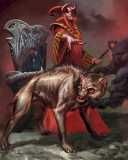
CATFOLK
“Wherever the plains take me, that is where I will wander.”
—Marrash of the Flying Eagle Tribe, catfolk scout
The great tribes of the catfolk roam where they will, putting
passion into every day of their varied lives.
Catfolk nomads roam the grassy plains, living in tribes
segregated by their visual differences. Catfolk tribes range
from friendly to hostile; encounters with catfolk depend more
on an individual catfolk’s mood and the circumstance more
than any tribal mind-set. Quick in movement and thought,
the catfolk rely on short bursts of energy to accomplish
nearly every task, making the other races seem plodding and
dedicated in comparison.
CATFOLK RACIAL TRAITS
Catfolk resemble a cross between a large predatory cat and
a human, with a sleekly muscled humanoid body and the
head and mane of a feline. Most male catfolk wear their
thick hair in braids, while females keep theirs short and
sleek. The most common catfolk have feline characteristics
reminiscent of lions, including thick manes for the
males. Other groups have the characteristic markings and
appearance of leopards, tigers, or cheetahs. Catfolk have
thicker nails than other humanoids, but not the powerful
claws of their feline counterparts, and they make unarmed
attacks just like humans. Many catfolk favor the use of
charms and totems that they braid into their hair for luck
in battle, success on the hunt, and good fortune in other
such endeavors.
Catfolk speak Common and a language called Feline (each
tribe speaking a dialect). Brighter catfolk often learn the
languages of gnolls and halfl ings.
Catfolk characters possess the following racial traits:
• +4 Dexterity, +2 Charisma.
• A catfolk’s base land speed is 40 feet.
• Low-Light Vision: Catfolk can see twice as far as a human
in starlight, moonlight, torchlight, and similar conditions
of poor illumination. They retain the ability to distinguish
color and detail under these conditions.
• Racial Skills: Catfolk have a +2 racial bonus on Listen and
Move Silently checks.
• +1 natural armor bonus.
• Automatic Languages: Common, Feline. Bonus Languages:
Draconic, Gnoll, Halfl ing, Sylvan.
• Favored Class: Ranger.
• Level adjustment +1.
CATFOLK SOCIETY
Catfolk maintain a tribal society similar to that of many
nomadic human cultures.
Lands: Catfolk roam the open grasslands in temperate
and tropical regions, shunning the colder lands even
in the heights of summer. Wandering tribes of catfolk
rarely come close to the large cities of other races, but
they occasionally camp within sight of a smaller town
or village in order to trade. Catfolk roam great distances
in their travels and do not become attached to a specific
range or territory the way that nomadic tribes of humans
sometimes do.
Settlements: Catfolk encampments balance defensibility
with ease of escape from a dangerous area. Generally circular
in nature, catfolk encampments center on a communal area
where children play and the elders care for them and practice
their crafts. The tents and lean-tos of individual families range
out from this center, with the most able warriors occupying
tents on the perimeter of the encampment.
Power Groups: With no large nations or powerful alliance
of tribes to bind them together, catfolk experience little of the politics and power struggles that defi ne the
societies of other races. Instead, most tribes receive
guidance from three sources: the outriders, the
druids, and the chieftain. The outriders are the
most skilled scouts of the tribe, and they govern
the direction that the tribe hunts and travels, unless
the chieftain overrules their choice. The druids,
the primary source of healing and magical power
within the society, hold a great deal of
infl uence over most aspects of catfolk
life and often advise the chieftain on
important matters. The chieftain makes
decisions on everything that affects
the tribe as a whole.
Beliefs: A deeply spiritual people,
cat folk usually worship one deity to the exclusion
of others. Most catfolk follow the
precepts of Obad-Hai, and their most
prominent religious fi gures are druids
devoted to the service of the god of nature.
Catfolk revere Obad-Hai more for
his connection to nature’s power and
his governance of plants and animals
than for his connection to the primary elemental forces
such as fi re or water.
Other catfolk, particularly adventurers and travelers, pay
homage to Fharlanghn. While most tribes of catfolk move
around in a nomadic fashion, a few travel much more than
others and keep Fharlanghn as their primary deity.
Relations: Catfolk get along well with members of
just about every other race. They admire those who live
in the wild more than city dwellers. Because of this, they
seek out the company of halfl ings, wood elves, and gnolls.
Catfolk have a hard time understanding the slow, steady
approach that dwarves take to life, and the two races have
little in common. Because they are such opposites in both
temperament and physical abilities, catfolk and dwarves
rarely enjoy the other’s company, although no real animosity
exists between the races.
CATFOLK CHARACTERS
Agile and charismatic, catfolk characters make excellent
rogues and rangers.
Adventuring Catfolk: Adventuring catfolk feel the
restlessness common to their people more acutely than most.
The thrill of discovery and a great sense of curiosity drive
these adventurers to break from their tribes and wander other
lands. Beyond simple wanderlust, some catfolk fi nd the heat
of combat exhilarating, and the rush of danger draws the
catfolk adventurer ever onward.
Catfolk admire adventurers and see accomplished
adventurers as great assets to the tribe. The nomadic life
of the catfolk is fraught with danger and unexpected
encounters, and the life of the typical catfolk is more akin
to that of an adventurer than the life of a typical human
or elf.
Character Development: Catfolk should select feats
and skills that take advantage of their high Dexterity or
mitigate the drawbacks of their +1 level adjustment. The
easiest way to do this is through ranged combat—it turns
the catfolk’s high Dexterity into a bonus on attack rolls
and keeps the monsters at a distance, minimizing the
catfolk’s lack of a Hit Die relative to other characters of
the same ECL.
Character Names: Catfolk favor names that begin with
“D,” “M,” or “N” and contain multiple “s” and “r” sounds. A
catfolk clan name translates into Common as a participle
(a verb made into an adjective by adding “-ing”) followed by
a noun.
Male Names: Densharr, Mersharr, Nermissar, Therrass.
Female Names: Dessirris, Mianissa, Morasha, Nera,
Thessana.
Clan Names: Flying Eagle, Hunting Tiger, Running Brook,
Screaming Arrow.
ROLEPLAYING A CATFOLK
Catfolk respond to the varied experiences of life with passion
and emotional intensity. They accomplish as much in their
quick but short-lived bursts of activity or emotion as other
races do at their relatively plodding pace. Catfolk relish both
the heated ferocity of battle and the warmth of a quiet meal
with trusted companions.
Personality: Catfolk share a quick and engaging confi
dence that makes them seem always ready for the next
challenge. Quick to anger and just as quick to forgive, catfolk
live a life fi lled with emotion. Members of most races fi nd
catfolk pleasant company despite their mercurial temperament, finding their free-flowing emotion and enjoyment
of life refreshing and captivating. The emotional catfolk
have a darker, dangerous side as well, and they are as likely
to meet an insult with a drawn weapon as they are to shrug
it off with a jest.
Roleplaying Application: Let your emotions come to the
surface at every opportunity. When you form an opinion,
express it. React passionately to most encounters, drawing
weapons when a fight is eminent and offering welcome to
those who seem friendly. Don’t be shy about criticizing
the things you don’t like. Don’t be stingy with praise for
those things you enjoy.
Behavior: Catfolk move in quick bursts of speed rather
than in one steady gait. Even when covering long distances,
they intersperse short dashes with short periods of rest.
Members of other races find this style of movement almost
impossible to emulate, but to catfolk it’s much less tiring than
simply trudging on at a steady pace.
Catfolk also place great importance on small tokens that
serve as physical connections to their memories, and they
view these special tokens as having physiological importance
if not true magical power. Adult catfolk carry several such
tokens with them at all times, ranging from objects as large
as weapons and armor that served well in past battles to
items as subtle as a small brooch that the character wore on
an important day in the past. For catfolk, this tradition is a
deeply personal experience, and the highest compliment a
catfolk can pay someone is to present one of his tokens as a
gift and explain its significance.
Roleplaying Application: If you use miniatures while
exploring a dungeon, you can represent your actions
visually by moving a short distance ahead each time the
group clusters or falling behind a bit as the group moves
on and then catching up in a burst of speed. If you don’t
use miniatures, or if you only use them during combat,
emphasize the way you move by describing your movements
as jumping or dashing rather than walking. Take
the time to be clear about your character’s position relative
to the rest of the party.
You should pick a minor token that has special meaning
to you at least once a level. Although these tokens may
sometimes be weapons or items that helped you or your
companions through a trying battle, most should be simple
items that others would never suspect hold such meaning. As
a sign of great respect and friendship, you can present one of
these items to another character or to an NPC, but you should
do this at most every few levels. Such tokens might include
the dagger a friend gave you a long time ago, the fletching
from the arrow that killed the first game animal you took
down, or a well-worn bowl that your grandfather carried
with him on his adventures.
Language: Catfolk have their own language, which they
use primarily for conversation with other members of their
race. Regardless of whether they communicate in Feline,
Common, or some other language, catfolk express their
opinions quickly and expect others to do the same. Catfolk
can listen to others patiently enough, but once they have
expressed a clear opinion, they expect the conversation to
come to a conclusion quickly. They have little time for those
who attempt to persuade or debate by simply restating their
opinion. They grow bored when others take a long time to
reach a point or who view an exchange of opinions as a trial
of endurance.
Roleplaying Application: Don’t debate—take the time to
listen to others and then express your opinion or view.
Only express your opinion once, but don’t be abrupt or
blunt. Maintain an open attitude toward the thoughts of
others. Express your emotions openly in conversations,
magnifying most responses to represent greater heights
of emotion.










